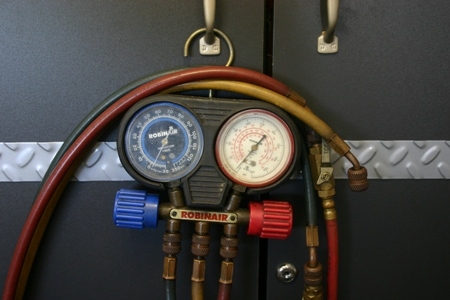134A AC Refrigerant Manifold Gauge Set – Air Conditioning Tools
June 7, 2009 12:31 pm Air Conditioning, DIYRobinair AC Manifold gauge set was originally for R12, it has been adapted for 134A
To properly diagnose an AC system the use of a manifold gauge set is needed. AC gauge pressure readings help professional auto technicians determine if the system is low and exactly what is going on with the car’s A/C system. A 134A gauge set is also used when attaching a vacuum pump to the car for evacuating/removing the air out of AC components. If air is left in the system, the moisture it contains combines with refrigerant under pressure can cause a corrosive acid to form that can destroy evaporators, condensers or even the AC compressor from the inside.
So obviously since air mixed with 134A refrigerant is such a harmful combination, whenever service has been performed, evacuating the system with a vacuum pump is recommended. Simply pull a vacuum down on the AC system with the use of a manifold gauge set and a vacuum pump prior to charging the system. When the system is in a vacuum the boiling point is also reduced which in turn removes moisture that would otherwise be left behind.
What are the best brands when it comes to an AC manifold gauge set?
- Like most things we purchase, the cheaper brands are usually of inferior quality. It also depends on how much use the 134A Gauge set will be exposed to. I would recommend staying away from the lower end products sold by some parts stores or Harbor Freights. The brands that professionals use is what I would recommend like CPS, Robinair and Mastercool.
How does a vacuum pump attach to the car’s AC system?
- The evacuation process is only done with NO refrigerant in the car’s air conditioning system. If any refrigerant is in the vehicle it must be recovered by an AC recovery machine. In the old days the refrigerant was just released (vented) but that is illegal now as it should be, due to environmental concerns. With an empty system, the yellow hose on the AC gauge set attaches to the vacuum pump. The red hose attaches to the high side (large fitting) and the blue hose attaches to the low side (small fitting) on the car. The high and low side valves are opened and the vacuum pump turned on. The needles on the gauges will go down with the blue low side reading 28-29 in the vacuum range.
After the system has been in vacuum for at least fifteen minutes, how is the system charged?
- Both valves are closed on the 134A manifold gauge set. Then the vacuum pump is disconnected. If using a can tap with small cans the correct amount of refrigerant is added. Consider the capacity of the cans and see how much Freon the car holds by checking the specifications for the car – most of the time there will be sticker under the hood. If using a 30 pound container a weight scale has to be used to obtain the correct amount.
Why don’t I see the mechanic at the shop using a weight scale?
- Professional auto repair techs will use an AC machine most of the time with a scale built into the unit. The AC recovery machine will not just recover, it will recycle, vacuum a system down and correctly charge a car’s air conditioning system. A good AC machine is a real money maker for a shop that does a lot of AC work. It’s also required by law to properly recover the refrigerant. It’s an added bonus to the shop, since they are able to recycle the Freon and then sell it back to the customer.
I don’t understand what my gauge readings mean, can you help?
- That is a subject for a different auto repair article – luckily we have that covered, see AC Gauge Readings Explained.
What I look for in an AC Manifold Gauge set is a quality brand and I prefer 72″ hoses to allow a longer reach. It’s nice to be able to hook the gauges up, hang them from the hood and still be able to reach the source tank on the floor or service cart. I used a cheap gauge set once and the hoses were so short that after hooking up to the car and the freon tank it wouldn’t reach the hood. Brass manifolds are usually cheaper than aluminum block manifolds, that doesn’t matter to me as long as it’s a quality tool. I also prefer the needle type gauges and not the digital readout ones. Although I adapted it from R12 to 134A, I’ve had the same Robinair AC gauge set for twenty years and this remains one of the best air conditioning tools I’ve ever purchased!
